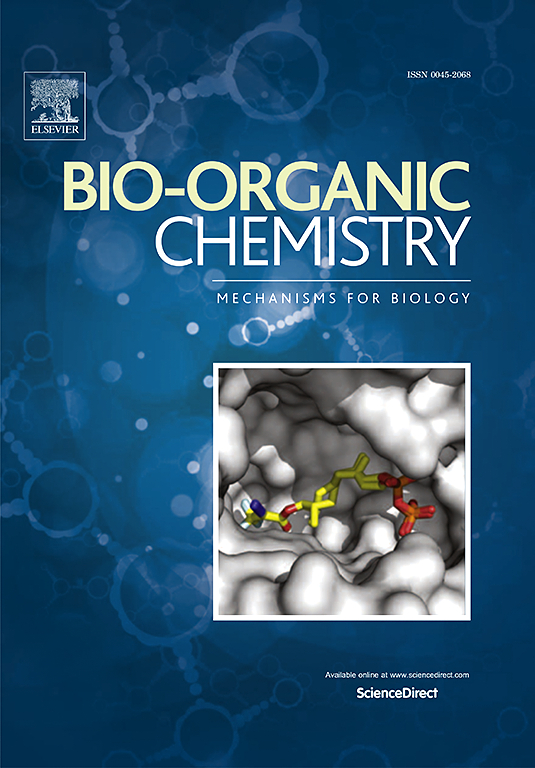由 SN38 修饰的 [12]aneN3 和生物素化脂类组成的混合纳米粒子用于肺癌靶向协同治疗
IF 4.5
2区 医学
Q1 BIOCHEMISTRY & MOLECULAR BIOLOGY
引用次数: 0
摘要
化疗与基因联合治疗肺癌因其具有较高的协同治疗效果而不断受到关注。本文设计并合成了3种新型的酯酶响应型前药基两亲体SCN1 ~ SCN3,它们分别由7-乙基-10-羟基喜树碱(SN38, S)和二(三唑-[12]- aneN3, N)片段通过不同长度的碳链(分别为C、5、7、11碳烷基链)组成。两亲体表现出优异的自组装能力和有效凝聚释放siRNA的能力,其中SCN2对A549细胞的增殖抑制效果最好。此外,将SCN2、siRNA、DOPE (D)和DSPE-PEG2000-Biotin (B)共组装成平均尺寸为198 nm的混合纳米粒子(SCN2- db /siRNA),具有良好的血清耐受性、高靶向性和生物相容性。此外,在酯酶存在的情况下,SN38(80%)和siPLK1(大量)的释放明显增加。体外实验证实SCN2-DB/siPLK1 NPs能有效抑制A549细胞的增殖、迁移和侵袭。体内实验表明,SCN2-DB/siPLK1 NPs有效抑制肿瘤生长(90%),毒副作用可以忽略不计。结果表明,SN38与siPLK1通过酯酶反应性两亲体结合为肺癌治疗提供了化疗、基因治疗和靶向给药相结合的策略。本文章由计算机程序翻译,如有差异,请以英文原文为准。
![Hybride nanoparticles composed of SN38-modified [12]aneN3 and biotinylated lipids for targeted and synergistic lung Cancer therapy](https://img.booksci.cn/booksciimg/2025-3/101302867951775161010.jpg)
Hybride nanoparticles composed of SN38-modified [12]aneN3 and biotinylated lipids for targeted and synergistic lung Cancer therapy
The combination of chemo- and gene-therapy for lung cancer therapy has attracted continuous attention due to its high synergistic therapeutic efficiency. Here, three novel esterase-responsive prodrug-based amphiphiles, SCN1 ∼ SCN3, composed of 7-ethyl-10-hydroxycamptothecin (SN38, S) and di-(triazole-[12]aneN3, N) moiety through different length of carbon chain (C, 5, 7, 11‑carbon alkyl chains, respectively) were designed and synthesized. The amphiphiles displayed excellent self-assembly capabilities and the ability to effectively condense and release siRNA, and SCN2 showed the most effective in inhibiting proliferation of A549 cells. Furthermore, SCN2, siRNA, DOPE (D) and DSPE-PEG2000-Biotin (B) were co-assembled into hybrid nanoparticles (SCN2-DB/siRNA) with an average size of 198 nm, outstanding serum tolerance, high targeting capability, and biocompatibility. Additionally, the release of SN38 (80 %) and siPLK1 (abundant) were observed clearly in the presence of esterase. In vitro experiments verified that SCN2-DB/siPLK1 NPs could efficiently suppress the proliferation, migration, and invasion of A549 cells. In vivo experiments demonstrated that SCN2-DB/siPLK1 NPs efficiently inhibited tumor growth (90 %) with negligible toxic side effects. The results showed that the combination of SN38 and siPLK1 through esterase-responsive amphiphile provided a strategy for lung cancer therapy that combined chemotherapy, gene therapy, and targeted delivery.
求助全文
通过发布文献求助,成功后即可免费获取论文全文。
去求助
来源期刊

Bioorganic Chemistry
生物-生化与分子生物学
CiteScore
9.70
自引率
3.90%
发文量
679
审稿时长
31 days
期刊介绍:
Bioorganic Chemistry publishes research that addresses biological questions at the molecular level, using organic chemistry and principles of physical organic chemistry. The scope of the journal covers a range of topics at the organic chemistry-biology interface, including: enzyme catalysis, biotransformation and enzyme inhibition; nucleic acids chemistry; medicinal chemistry; natural product chemistry, natural product synthesis and natural product biosynthesis; antimicrobial agents; lipid and peptide chemistry; biophysical chemistry; biological probes; bio-orthogonal chemistry and biomimetic chemistry.
For manuscripts dealing with synthetic bioactive compounds, the Journal requires that the molecular target of the compounds described must be known, and must be demonstrated experimentally in the manuscript. For studies involving natural products, if the molecular target is unknown, some data beyond simple cell-based toxicity studies to provide insight into the mechanism of action is required. Studies supported by molecular docking are welcome, but must be supported by experimental data. The Journal does not consider manuscripts that are purely theoretical or computational in nature.
The Journal publishes regular articles, short communications and reviews. Reviews are normally invited by Editors or Editorial Board members. Authors of unsolicited reviews should first contact an Editor or Editorial Board member to determine whether the proposed article is within the scope of the Journal.
 求助内容:
求助内容: 应助结果提醒方式:
应助结果提醒方式:


